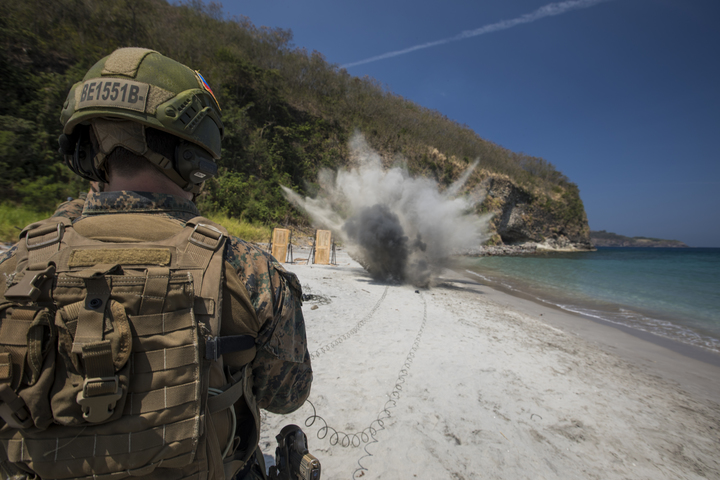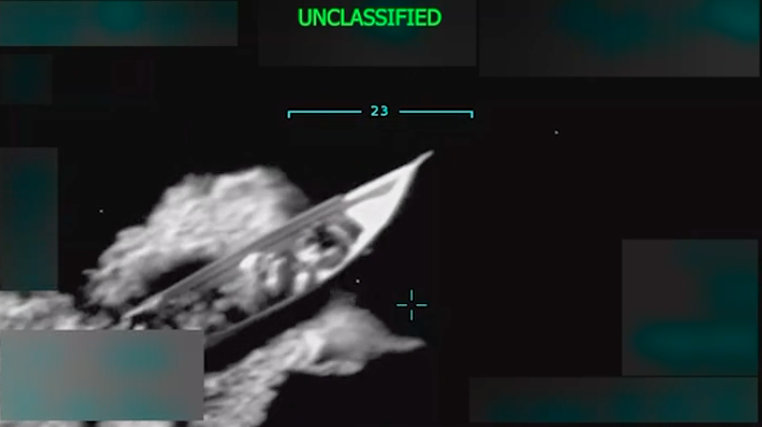Scaling the Counterrorism Return on Investment in Support of Great Power Competition
How can the U.S. build a sustainable and cost-effective counterterrorism operational concept?

Published by The Lawfare Institute
in Cooperation With

A rise in terrorist activities due to the coronavirus pandemic has drastically constrained affected governments’ ability to conduct effective counterterrorism operations. For example, Islamic State-affiliated fighters were able to take control of a strategic port in Mozambique as well as gain traction back in Iraq. In short, it appears we cannot divorce great power competition against China, Russia and other revisionist states, as stipulated in the U.S. National Security Strategy, from the counterterrorism fight. Instead of trying to divorce the two efforts, it is time for the United States to begin employing a robust adviser-centric counterterrorism operational approach to achieve a sustainable and cost-effective counterterrorism strategy.
As we just witnessed in France, where a self-radicalized Islamist cut off the head of a school teacher, violent extremist terrorism is not going away. The next U.S. presidential administration will need to reassess which types of counterterrorism operations are sustainable in an environment focused on great power competition. To fight the global war on terror, the U.S. has used two operational concepts: direct action and security force assistance. Over the past 20 years, the war on terror has cost the U.S. an estimated total adjusted $6.4 trillion, 52,802 casualties and 6,967 deaths, according to Brown University’s Costs of War project. Until 2016, the U.S. annually employed a quarter to a third of U.S. military and interagency assets toward direct action-focused counterterrorism. Under guidance from the 2017 National Security Strategy and the 2018 National Defense Strategy, counterterrorism is now fifth of five national security priorities (the other four are China, Russia, North Korea and Iran). Since 2002, fighting terrorism on average has cost the United States $100 billion each year and employed more than 200,000 people.
These costs are neither sustainable nor scalable given the accelerating diffusion of violent extremism. But it does not have to stay this way. The United States can better align its counterterrorism operations with its national defense strategy by adopting an indirect approach to keeping violent extremism from metastasizing in the first place. In this post, we show that a counterterrorism approach based on security force assistance is both more sustainable and better aligned with the 2018 U.S. National Defense Strategy than a direct action approach. First, we unpack how direct action-centric counterterrorism is becoming increasingly incongruent with the overall threat environment. Second, we offer a more scalable option to align counterterrorism with great power competition derived from operational lessons we draw from the Philippines.
U.S. direct action-centric counterterrorism consists of operations where the U.S. military and law enforcement conduct raids that capture or kill terrorists and their supporters. As the wars in Iraq and Afghanistan drew down, Joint Special Operations Command (JSOC) took the lead in these raids and is conducting the majority of direct action-centric counterterrorism missions globally. Though numbers are classified, various estimates state that JSOC grew from an organization of more than 4,000 people to one of more than 20,000 with a total budget of several billion dollars. Throughout the global war on terror, JSOC was responsible for the most high-profile direct action counterterrorism operations, including the raids on Osama bin Laden, Abu Bakr al-Baghdadi and Abu Musab al-Zarqawi. In Iraq and Afghanistan, JSOC killed many lower level terrorists through nightly raids at a huge cost per terrorist killed.
Yet research indicates that after each direct action counterterrorism operation, the terrorist organization would regenerate, and so the U.S. military, the intelligence community and JSOC would start the hunt again. From 2006 to 2011, for example, the U.S. military conducted direct action operations, killing or capturing most of the terrorists in Iraq. Then the U.S. military departed, leaving the Iraqi Security Forces in 2012 to maintain the peace. By 2014, the Islamic State arose and advanced fast toward Baghdad. The corrupt, fractured, poorly trained and poorly led Iraqi Security Forces collapsed. Then, the U.S. military returned and killed most of the Islamic State fighters by 2019, only to depart again. In Libya, Yemen, Somalia, and other places, JSOC and the CIA have killed innumerable terrorists. Yet the terrorist organizations grow more. On Sept. 11, 2001, the U.S. State Department listed 21 recognized terrorist organizations. As of October 2020, the State Department has added 48 additional terrorist groups to the list and removed 10. After almost 20 years of primarily direct action-centric counterterrorism operations, there are more terrorist organizations in 2020 than on 9/11. Like punching a pool of water, once you stop punching the water returns. U.S.-led direct action-centric counterterrorism may be tactically effective but operationally and strategically inconsequential. Moreover, we also show that it has become massively cost-prohibitive.
In contrast, a counterterrorism strategy focused on security force assistance is a less costly and more productive operational approach, but it is far more time consuming than direct action. Security force assistance, according to a military publication, includes “DOD activities that contribute to unified action by the U.S. government to support the development of the capacity and capability of foreign security forces and their supporting institutions.” Most security force assistance funding is currently bundled under Section 333 of the 2017 National Defense Authorization Act, and the Defense Security Cooperation Agency currently leads the Defense Department security assistance mission. In contrast to the average $100 billion plus annually spent for direct action counterterrorism operation, the U.S., through the Defense Security Cooperation Agency, spends on average $1.5 billion annually on all security force assistance programs outside of Iraq and Afghanistan.
U.S. security force assistance-based counterterrorism missions, since Sept. 11, 2001, were pursued primarily in more than 30 sovereign countries. A security force assistance-based counterterrorism approach was employed in these countries because the direct action approach was deemed too politically costly. Security force assistance programs focus on building competent host-nation military, police, intelligence and corrections forces that can hunt and eliminate terrorist organizations operating in the host nation. Successful security force assistance programs require restraint, patience, command support and command emphasis, not a support agency, such as the Defence Security Cooperation Agency, which just processes cases.
An example of a security force assistance-based counterterrorism operational approach was conducted in the southern Philippines. On May 27, 2001, three months before 9/11, three American citizens, Martin and Gracia Burnham and Guillermo Sobero, were kidnapped by a local al-Qaeda-affiliated Islamic terrorist organization—the Abu Sayyaf Group. The U.S. did not send a direct action force to recover the three Americans. Instead, after consultations between the Philippine and American presidents, Joint Task Force 510—a six-month American training, equipping and advising security force assistance mission—was deployed to the southern Philippines on Jan. 10, 2002.
Over the next six months, the Philippine army, advised by Joint Task Force 510, conducted several rescue attempts. Sobero was beheaded by the Abu Sayyaf Group in May 2002. On June 7, 2002, the Philippine army almost rescued the Burnham couple. During the firefight with the terrorists, Martin was killed and Gracia was wounded. On June 8, after more than a year in captivity, Gracia escaped and was recovered by Philippine forces. The hostage situation took more than a year to resolve, but the security force assistance mission to build the Philippine security forces into a capable counterterrorism force had just begun.
After six months, Joint Task Force 510 became Joint Special Operations Task Force—Philippines, which continued the security force assistance mission through 2015. This was the largest security force assistance-focused counterterrorism mission conducted by the U.S. during the global war on terror and paralleled the wars in Iraq and Afghanistan. After 2015, a residual adviser force, no more than 200 individuals, remained. In 2017, after the siege of Marawi, the task force became Operation Pacific Eagle—Philippines and continued to advise and assist the Philippine security forces. It took 16 years to build a capable Philippine counterterrorism force capable of hunting the constellation of terrorist groups around the Abu Sayyaf Group, with limited U.S. support.
Joint Task Force 510 and Joint Special Operations Task Force—Philippines consisted initially of 1,300 but decreased to no more than 600 U.S. service members, interagency partners and contractors deployed annually between 2002 and 2015. This is contrasted with an average of 50,000 personnel in Afghanistan during that same time period. On average, Joint Special Operations Task Force—Philippines operations were estimated to cost $50 million a year compared to $2 billion a week in Afghanistan over the same 13 years between 2002 and 2015. Currently, Operation Pacific Eagle—Philippines is estimated to consist of more than 300 individuals and cost approximately $90 million a year. According to the 2020 Department of Defense inspector general report, most of the Operation Pacific Eagle—Philippines expenses are for contract intelligence, surveillance and reconnaissance ($43 million) and contract helicopter support ($24.8 million). In the Philippines, the Americans did not go on nightly raids against the terrorists in the jungles and sprawling urban centers as they did in Iraq and Afghanistan. Unlike in Iraq and Afghanistan, where the U.S. conducted most of the direct action counterterrorism missions, in the Philippines it was the Philippine counterterrorism soldiers and police conducting all of the direct action counterterrorism missions.
Security force assistance missions require unique operators with a variety of advisory skills that span institution building, unit equipping and organizing, advanced skills, combat advisory and, most importantly, time. Critical to the advisory mission were U.S. Special Forces Crisis Response Force operators that U.S. Army Special Operations Command recently disbanded. As Secretary of Defense Mark Esper testified recently to the House Armed Service Committee, these operators are rarely used to conduct direct action and hostage rescue missions. Rather, the Special Forces Crisis Response Force operators, unlike their JSOC counterparts, are more than just manhunters. They are also master trainers in how to leverage local knowledge and capability. They were the principal trainers and advisers of the elite Philippine counterterrorism military and police units that brought the fight to the Abu Sayyaf Group and others in the Philippines.
In a resource-constrained environment, the U.S. requires a contact force, as outlined in the 2018 National Defense Strategy Global Operating Model, in order to sustain a security force assistance-focused counterterrorism approach while competing against China and Russia. In fact, a security force assistance approach to counterterrorism would also aid great power competition by closely aligning U.S. national security interests with the most capable local security forces. To conduct security force assistance properly, the U.S. needs the right combination of persistent and rotational advisers from the special operations forces, conventional forces and interagency. The U.S. requires empowered and networked advisers in the single and double digits deployed globally and answering to a command focused on containing global terrorism through a security force assistance-centric strategy. This strategy would reduce costs from $100 billion to $5 billion annually and require only approximately 10,000 active, reserve and interagency personnel instead of the current more than 200,000 dedicated personnel. Direct action will have a role to play when such bilateral partnerships are not mature for localized kill-and-capture missions against terrorists that threaten the United States and its interests. But our proposed security force assistance approach will in fact help direct action units prioritize their missions.
Success in the global war on terror will not occur when the U.S. continues to rely on direct action kill-and-capture missions against the next terror mastermind in an ungoverned space after a climatic event. Instead, the war on terror will recede when that would-be terror mastermind is taken care of before he or she reaches the emir level by a networked local counterterrorism force empowered by U.S. advisers. The development of local intelligence is key to this type of counterterrorism operation—an activity that direct action units are not equipped to perform without employing costly and at times intrusive national-level assets better suited to counter China and Russia. This approach of nipping terrorist leadership in the bud is nearly impossible to execute unilaterally, especially when more resources are needed to support countering the Chinese Communist Party, the Kremlin and other revisionist states. A local counterterrorism capability that is trained, advised and networked with persistent and episodic U.S. advisers who possess the unique skills required for that locality is the solution. The employment of a robust security force assistance-centric counterterrorism operational concept is required to achieve a sustainable and cost-effective global war on terror into the next decade that will protect the U.S. homeland and free up the majority of U.S. military personnel and resources to focus on great power competition.





